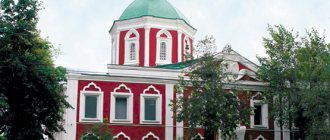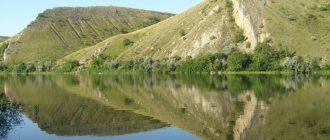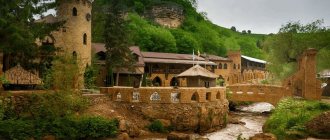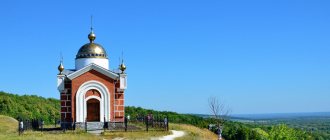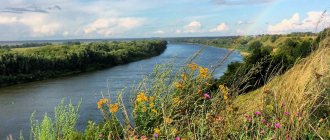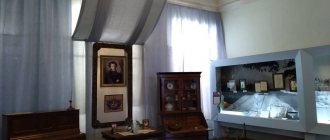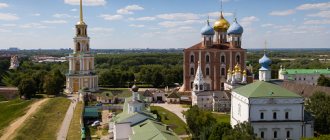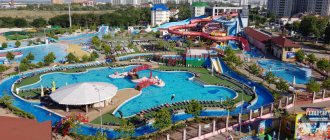My personal TOP of interesting places to go in Kazan. You will find the best in the article “My TOP 15 interesting places”. Here is everything that seems to me worthy of your attention and that you can easily see in three days in Kazan. The first day I walked, the second I rode a bike, and the third I walked again, in relaxation mode. Kazan is rich in attractions, but they are compactly located. There's enough time for everything.
Kazan city (Russia)
Kazan is one of the oldest cities in Russia, located in the Middle Volga on the Kazanka River. It is the capital of the Republic of Tatarstan and the largest city in the Volga region. Kazan is one of the most beautiful and interesting places in Russia, a city with a magnificent historical and cultural heritage. The most famous landmark of the capital of Tatarstan is the Kremlin, which is included in the list of UNESCO World Heritage Sites.
Kazan has a thousand-year history and is often called the “third capital of Russia”. Since ancient times, the city has been a kind of bridge between East and West, which has had an interesting effect on its architecture, culture and even atmosphere. Here, Christian churches coexist with Muslim mosques, magnificent ancient palaces with modern buildings, giving the capital of Tatarstan an amazing flavor.
Kul Sharif Mosque
Address: Kazan, Kremlin, building 13.
The Muslim sights of Kazan are represented by the largest mosque in Europe, the Kul-Sharif mosque (or “blue mosque”). This is a monument dedicated to the last imam of Kazan, Kul-Sharif, a great religious figure. The building was erected in place of the mosque of the same name destroyed in the 16th century during the capture of Kazan.
Dedicated to the celebration of the millennium of Kazan, the 57-meter building has 5 floors with an observation deck and minarets. The mosque is richly decorated with ornamental and semi-precious stones. In the prayer hall you can see symbols of Islam: tulips and crescents, as well as suras from the Koran inscribed in gold, stained glass and mosaics, rare Iranian carpets, and a handmade model of the building.
Guides: Russia
Moscow
Saint Petersburg
May be interesting: Other cities in Russia
Temple of All Religions
Address: Kazan, Staro-Arakchinskaya st., 4
The sights of Kazan are a clear example of the eclecticism of styles and the synthesis of cultural traditions, which is manifested in the unusual architectural appearance of the Temple of All Religions.
The modern building of the temple, built on the initiative of the public figure and creative person Ildar Khanov, embodies the humanistic idea of equality of all religious faiths and movements - both existing and disappeared or legendary. This idea is reflected by the lack of a unified style, multi-colored mosaics and the general pretentiousness of the decor.
The temple was supposed to include 16 halls dedicated not only to Christianity, Buddhism, Islam, but also to exotic movements: Egyptian mythology, Freemasonry, Mayan religion, etc. At the moment, the temple is being completed.
Geography and climate
Kazan is located in the east of the European part of Russia, 800 km from Moscow. The capital of Tatarstan was built on the left bank of the Volga at the confluence of the Kazanka River, which divides the city into two parts: the southern historical part and the more modern northern part. The relief of Kazan is predominantly flat with low hills.
The climate of the city is temperate continental. It is characterized by relatively cold and snowy winters, as well as warm, slightly rainy summers. The best time to visit the capital of Tatarstan is from May to September.
Panorama of Kazan
Tower Syuyumbike
Address: Kazan, Kremlin.
The Syuyumbike watchtower is known outside of Russia not only because it was presumably built in the 16th or 17th centuries (it is impossible to reliably determine the date due to lack of documents), but also because it is an “analogue” of the famous leaning Leaning Tower of Pisa: its spire deviates from the vertical by almost 2 meters.
The style of the 58-meter structure combines features of Tatar and Russian architecture (one can notice the similarities with the Spasskaya Tower of the Moscow Kremlin), although the authorship has not been established. It is only known that the upper part was rebuilt in the 18th century.
The history of the tower is shrouded in many legends, but they all agree on one thing: the building is dedicated to the queen of the Kazan Khanate Syuyuk, or Syuyumbika (“beloved lady”), known for her good deeds and who lived during the reign of Ivan the Terrible.
Story
The history of Kazan goes back more than a thousand years. Scientists believe that the settlement on the site of the modern city was founded around 1005. Initially, a fortress was built here on the northern border of Volga Bulgaria. In the 13th and 14th centuries, Kazan became an important center of the Golden Horde.
In 1391 the city was first mentioned in chronicles. In 1438, Kazan was captured by Khan Ulu-Mukhamed and became the capital of the Kazan Khanate. Over the next hundred years, the Khanate repeatedly fought with the Principality of Moscow and, ultimately, in 1552, Kazan was taken by Ivan the Terrible.
Kazan Kremlin
In 1556, construction of the Kremlin began here. By the 17th century, Kazan had become one of the most important cities in Russia, and at the beginning of the 18th century it became the capital of the Kazan province. A university was founded here in 1804.
The most beautiful capital of Tatarstan
The main city of the Republic of Tatarstan is more than 1 thousand years old. Officially, over 1 million people live in Kazan. This historic city welcomes hundreds of thousands of tourists every year. And this is not surprising, because there are a large number of different attractions here.
The beauty of Kazan is a topic that can be discussed endlessly. I have lived here since birth and I can proudly say that I have the most sincere and warm feelings for this city.
My favorite place in the city has always been a small island. It is called Marquis. In the summer I like to come here with a blanket, lay it out in the shade of the trees, read a book or work on some school project or report that was assigned during the holidays. Time flies by unnoticed here, and in the evenings you can watch the most beautiful sunset of an unusual milky pink hue.
However, at other times of the year Kazan fascinates with its beauty. Winter, spring, summer, autumn replace each other, painting the city in different shades. It seems that life here never stops, even with the arrival of severe frosts. Many people mistakenly believe that it is not worth going here in winter. However, at this time of year, Kazan becomes like a fairy-tale town.
If anyone gets the opportunity to visit this corner of Russia, don’t even doubt the decision. Be sure to come!
How to get there
Kazan has a large international airport located 26 km south of the city. The capital of Tatarstan has regular air connections with most major cities in Russia, as well as cities in Turkey, Bulgaria, Greece, the UAE, and Thailand. In addition, Kazan is a major railway and transport hub. By car from Moscow you can get here via the M7 motorway.
Public transport in Kazan is represented by one metro line, numerous bus routes, tram and trolleybus lines. The Kazan metro includes only 10 stations. There are five tram routes.
What to see depending on the time of year
It is more pleasant to travel around Kazan in the summer months, when the air warms up to 20 degrees Celsius. After a city tour, head to the beautiful beaches of Kazan. The most popular is Lokomotiv. The advantages of the beach are a sandy shore, developed infrastructure. The disadvantage is that it is crowded. You can get to the beach by metro, exit at the Kremlyovskaya station. Next you need to walk another 1 km.
Lokomotiv Beach is the most popular in the city
Those who like a relaxing holiday will enjoy the Cordon beach, located 30 km from the city on the banks of the Volga River. There is no entertainment here, but the nature is perfect: clean water, clear air, golden sand. Near the beach there are coniferous forests where you can walk after water treatments. It is easier to get to the beach by car or taxi. When traveling by car, follow the route: Matyushinsky tract - Clear Lake - Oryol village - Cordon camp.
In winter, relax at the Kazan ski resort, which is visited annually by more than 100 thousand tourists. Here, among the snow-capped mountains, there are ski slopes of varying difficulty, skating rinks, and cozy houses for accommodation.
The Kazan ski complex is the largest in Tatarstan
The recreation center is open from November to April. Coordinates: Verkhneuslonsky district, Savino village. You can get to the site by car following the route:
- Leave the city along federal highway No. 7 and follow to Tyurlema.
- Turn towards the village of Tatarskoye Burnashevo and move to the sign for the GSOC “Kazan”.
- Turn left and continue for another 2 km.
Attractions
The Kazan Kremlin is the oldest part of the city and the most famous landmark of Kazan. It is a magnificent ensemble of historical, architectural and cultural monuments, surrounded by white stone walls. The origins of the Kazan Kremlin go back to the beginning of the 11th century, when a border Bulgarian fortress was built on this site. It acquired its current appearance in the 16th and 17th centuries, preserving several fragments from past periods.
The Kremlin in Kazan was built in the traditional Russian style by Pskov craftsmen, so its walls resemble a similar fortress in Pskov.
Kazan Kremlin
The Kremlin is located on the left bank of the Kazanka River on a hill. Its area is 15 hectares. The walls are 1.8 km long and reach 12 m in height. Eight towers and two gates have survived to this day.
The main attractions of the Kazan Kremlin
Syuyumbike
Syuyumbike is a high 58-meter brick watchtower, which is one of the architectural dominants of the Kremlin. Its exact date of construction is unknown. The first written mentions date back to 1777. The tower has a passage gate and is topped with a spire. Interestingly, Syuyumbike is a “leaning tower”. The deviation from the axis is about 2 m.
Kul Sharif
Kul-Sharif is the main mosque of Tatarstan, the construction of which was completed in 2005. Erected on the site of the historical mosque of the Crimean Khanate, destroyed during the capture of Kazan by the troops of Ivan the Terrible. Kul Sharif is built of granite and marble, has six minarets (four large and two small) and one dome.
Blagoveshchensky cathedral
The Annunciation Cathedral is the main Christian temple in Kazan and the oldest surviving monument of the Kremlin. It was built between 1555 and 1562 on the site of a wooden church, erected immediately after the capture of the capital of the Kazan Khanate. The cathedral was built by Pskov craftsmen and is a magnificent example of late medieval Russian architecture. In the 17th century, a high 50-meter bell tower was added to the church, but it was destroyed in 1928.
Spasskaya Tower
The Spasskaya Tower is the main tower of the Kazan Kremlin, built in the 16th century and has a height of almost 47 meters. It has four tiers and is built of white limestone. In the past, next to the tower there was a beautiful chapel, destroyed during Soviet times.
Taynitskaya Tower
The Tainitskaya Tower was built in the mid-16th century on the site of a hidden water source. During the time of the Kazan Khanate, the Nur Ali Tower was located on this site, through which Ivan the Terrible entered Kazan.
Southwest Tower
The South-West Tower is the same age as the Spasskaya Tower and was also built by Pskov craftsmen.
Presidential palace
The Presidential Palace is a beautiful historical building from the mid-19th century, built in the neo-Renaissance style (Russian-Byzantine style). The palace was once the residence of governors. During the time of the Kazan Khanate, the Khan's palace was located on this site.
Cannon Yard
The Cannon Yard is an ensemble of historical buildings from the 17th to 19th centuries in the Baroque and Classical styles. The complex was one of the largest places for the production and repair of artillery pieces in the Russian Empire and functioned until the mid-19th century.
Kremlin embankment
Kremlin Embankment is a colorful pedestrian street that begins at the walls of the Kremlin. It is one of the most popular places among residents and guests of the city for a walk. The embankment acquired its current appearance in 2013 - 2015.
Other sights of Kazan
Bauman Street is the central street of the historical center of Kazan, which begins at the Kremlin walls and stretches to Tukay Square. A huge number of architectural and cultural monuments are concentrated in its vicinity. This is also one of the oldest streets in Kazan. During the time of the Kazan Khanate, the Nogai tract ran here.
Bell tower of the Epiphany Cathedral
The Epiphany Cathedral was completely completed in 1756 and is located on Bauman Street in the depths of the courtyard. The temple was built in the Russian Baroque style and before the revolution had a richly decorated interior. What stands out in its architecture is the tall brick bell tower in the neo-Russian style, which for a long time was the tallest building in the historical center of Kazan.
Temple of all religions
The Temple of All Religions is a relatively modern architectural complex, built in 1994 and dedicated to all religions of the world. This colorful ensemble includes a Christian church, a Muslim mosque, a Jewish synagogue and a Buddhist pagoda.
Al-Marjani Mosque in Staro-Tatarskaya Sloboda
Staro-Tatarskaya Sloboda is a colorful historical district of Kazan, located between Lake Nizhny Kaban and the Bulak Canal. Its heart is Yunusovskaya Square. This part of Kazan is the historical center of the Tatar community (after the conquest of the city by Ivan Vasilyevich) and is a unique architectural ensemble of ancient buildings, palaces and mosques. Staro-Tatarskaya Sloboda is a great place to experience the culture of Tatarstan and see traditional Tatar architecture.
There are several ancient mosques in this area, among which al-Marjani stands out. This is one of the oldest mosques in Kazan, founded in the second half of the 18th century and for more than two centuries it has been the cathedral mosque of Tatarstan. Al-Marjani was built in the traditional Tatar style, has one minaret and predominantly Baroque architecture.
Tikhvin Temple
Tikhvin Church is one of the oldest churches in Kazan, located in the Staro-Tatarskaya Sloboda. The temple was founded at the end of the 17th century and rebuilt in neo-Russian style at the end of the 19th century.
Zilantov Monastery
The Zilantov (Uspensky) Monastery was founded in 1552 by Ivan the Terrible and is located approximately 5 km from the Kazan Kremlin on the hill of the same name. This hill plays a big role in the folklore of Kazan. According to legend, the winged serpent Zilant lived at its peak, which is now one of the symbols of the capital of Tatarstan.
The architectural ensemble of the monastery was formed in the 17th and 18th centuries and included several churches, a school and a seminary. During Soviet times, the monastery was closed, and its ancient buildings were practically destroyed. The All Saints Church of the 17th century has survived to this day, and relatively recently (in 2006) the Trinity Cathedral was erected.
Alexandrovsky Passage
Alexandrovsky Passage is one of the most striking buildings in Kazan in the style of eclectic architecture (modern and neo-baroque), built at the end of the 19th century by the merchant Alexandrov.
Farmers' Palace
The Farmers' Palace is an impressive modern landmark in the unusual bozar architectural style. The palace was built in 2010 near the Kremlin and the Kremlin embankment and in shape resembles the winter residence of the Habsburgs (Hofburg) in Vienna and the Altar of the Fatherland (Vittoriano) in Rome.
National Museum (right)
The National Museum is one of the oldest and largest museums in the Volga region. It was founded at the end of the 19th century, covers an area of more than 10,000 m2 and includes more than half a million exhibits. Archaeological artifacts, collections of porcelain, weapons, coins, art objects, old books and documents are presented here.
Peter and Paul Cathedral
The Peter and Paul Cathedral was built in Kazan in the first half of the 18th century in the Baroque style and is a striking example of the architecture of the era of Peter I. The temple also includes a 49-meter six-tier bell tower, decorated with beautiful Baroque decor. The interior of the church features a stunning iconostasis dating back to the 18th century.
Kazan
Kazan is a wedding palace opened in 2013. It has an original architecture, reminiscent of a traditional cast cooking pot. Nearby you can see several interesting sculptural compositions (a pair of zilants and leopards).
Spasskaya Tower
Address: Kazan, Kremlin.
Acquaintance with the Kremlin begins with an architectural monument of the 16th century - the four-tiered Spasskaya Tower (originally two-tiered, made of white limestone, and then built on with brick and completely whitewashed). The authorship of the structure is attributed to the Pskov architects Postnik Yakovlev and Ivan Shirai. The name of the tower is associated with the image depicted on the icon of the Savior Not Made by Hands.
The powerful structure, the fortress moat and 13 stone towers once served a defensive function: only 8 of them have survived. The hipped roof of the 46-meter building is decorated with a gilded star and a clock.
Palace of Water Sports
Address: Kazan, st. Sibgata Hakim, 70.
Another largest sports facility in Kazan is the Water Sports Palace. It was built in 2013 for the Summer Universiade. Various swimming, diving and water polo competitions are held here. The palace pools are available to the public for free swimming or under the guidance of a trainer. The huge palace building in the form of a billowing wave attracts attention.
Government body
When you hear the words “Ministry of Agriculture” or “General Directorate of Veterinary Medicine,” you feel like yawning, because you imagine a dull building from the outside with dimly lit corridors and a flickering lamp inside.
The interior decoration should be judged by employees and visitors of the Ministry of Agriculture of the Republic of Tatarstan. The tourist can only be amazed at the appearance of the palace, the columns and the twenty-meter tree inscribed in the arch of the building, because the Kazan landmark captured in the photo is an ordinary administrative building. The architect created it in the spirit of classicism and empire style, inspired by the Hofburg Palace in Vienna.
The Palace of Farmers was built between 2008 and 2010, although its appearance does not betray youth and looks organically opposite the ancient Kremlin walls, decorating the square on the embankment of the Kazanka River.
Address: Kazan, st. Sibgata Hakim, 4.
Another quaint building in Kazan - the Kazan Family Center (ZAGS) in the form of a Tatar cauldron was built in 2013 according to the design of Dasha Namdakov, it is often called simply the Bowl. The illumination also gives it a resemblance to a bowl, and decorative elements with ethnic motifs refer to the times of the Volga Bulgaria and the Kazan Khanate. At the center of the family there are three wedding halls: Golden, Silver and Oriental.
The bowl stands on the bank of the Kazanka River. On the roof of the building, at a height of 32 meters, there is an observation deck from which a panorama of the city opens up, in particular a view of the Kazan Kremlin. Therefore, here you can meet not only newlyweds and wedding guests, but also many tourists.
Ekiyat
Address: Kazan, Peterburgskaya st., 57.
An unusual building, in the form of a fairy-tale castle, appeared in Kazan in 2012. It houses the country's largest puppet theater "Ekiyat", a theater museum, as well as children's clubs, shops and cafes. The word “ekiyat” is translated from Tatar as “fairy tale”. The puppet theater in Kazan was created in 1934, most performances are held in Russian, but there are also in Tatar.
The building of the puppet theater has become a landmark of Kazan; it is proudly shown to tourists as a beautiful and original structure. In fact, the building is heavily overloaded with details and does not fit into the surrounding area in style; this is another architectural bad taste of Kazan.
Kazan Bogoroditsky Monastery
Address : Kazan, Bolshaya Krasnaya st., 5.
The Mother of God Convent, located next to the Kazan Kremlin, was founded in 1579 by decree of Ivan the Terrible on the site of the discovery of the miraculous Kazan Icon of the Mother of God, especially revered in Russia. According to legend, the icon was found after a big fire by a 10-year-old girl, Matrona. The Mother of God appeared to her in a dream and told her to go to the ashes of her house, where the icon was found.
The Kazan Mother of God Monastery has become the main place of pilgrimage in Kazan. In the 19th century, a magnificent architectural ensemble in the style of classicism was created here. The main cathedral of the monastery - the Kazan Icon of the Mother of God - was built according to the design of the famous architect Ivan Starov in 1798 - 1808 on the site of the Kazan Icon. It became the largest in the city - five-domed, with three portals, each of which had six columns.
Recreated Kazan Cathedral
Near the Kazan Cathedral, St. Nicholas Cathedral (1810-1816) and the Holy Cross Church (1882-1884) were built. From the 17th century buildings, St. Sophia Cathedral and a 6-tier bell tower organically fit into the ensemble of the monastery. The ensemble was completed by the Priory (1810-1832) and St. Nicholas (1832-1843) buildings, forming a vast semicircle together with St. Nicholas Cathedral.
Holy Cross Cathedral
In 1904, the Kazan Icon was stolen by Bartholomew Chaikin for the sake of a silver chasuble with pearls and diamonds, who was soon found and brought to justice. According to him, he cut the icon itself and burned it in the oven, thus the miraculous icon was lost forever. Chaikin was sentenced to 12 years of hard labor.
After the revolution of 1917, the richest Mother of God Monastery, in which there were more than 500 nuns alone, was closed. In the 1930s it was severely destroyed: the Cathedral of Our Lady of Kazan and the bell tower were blown up. A tobacco factory and a philological department of a pedagogical institute were located on the territory of the monastery, garages were added, and five-story residential buildings were built on the site of the monastery garden.
The restoration of the monastery began at the beginning of the 21st century. The large Holy Cross Church was restored and now houses the revered Vatican copy of the Kazan Icon of the Mother of God. In 2016, reconstruction of the Kazan Cathedral began on the former site.
Pedestrian street Bauman
The central pedestrian street of Kazan, stretching for almost two kilometers, is named after the revolutionary Nikolai Bauman, this is the Kazan “Arbat”. In addition to numerous modern shops and cafes, there is something for tourists to see. Developed by merchants in the 19th century, the street retains traces of the past: the Shalyapin Hotel with a monument to the singer, the Kachalov Theater (1833), the Printing House and the city magistrate building, the Solomin-Smolin house and the Karetnikov house.
Here are also located such religious attractions of Kazan as the St. John the Baptist Monastery, the 16th-century St. Nicholas Cathedral and the Epiphany Cathedral (where Fyodor Chaliapin was baptized, and the bell tower was long considered the tallest building in the city). On the street there is a monument to the Kazan cat and a bronze carriage of Catherine II. Various themed events are also held here.
Kazan University
Main building of Kazan University
Museum website: museums.kpfu.ru Address: Kazan, Kremlevskaya street, 18.
Kazan University was opened by Emperor Alexander I in 1804 and until 1917 it was called the Imperial Kazan University. At first, the university was located in the building of the Kazan Imperial Gymnasium. In the 20s of the 19th century, the architect P.G. Pyatnitsky built a two-story main building of the university in the city center with a classical facade 160 meters long, with three porticoes and 24 columns.
In the 1830s, the architect M. P. Korinfsky created the architectural ensemble of Kazan University. An anatomical theater, a chemical laboratory building, a library, an astronomical observatory and a clinic were built. Gradually, the university campus expanded beyond the historical quarter. In the 1970s, two high-rise educational and laboratory buildings were built.
As you know, V.I. studied at Kazan University. Ulyanov (Lenin), though not for long. Three months after entering the Faculty of Law, the famous revolutionary student gathering of 1887 took place, after participating in which Ulyanov was first arrested and sent into exile for a year. He never returned to the university, however, from 1924 to 2010 the university bore the name of Ulyanov-Lenin, now it is called the Kazan (Volga Region) Federal University (KFU).
Monument to young Ulyanov V.I.
In 1954, opposite the main building, on a semicircular area with benches, nicknamed by students the Frying Pan, a monument to young Ilyich was erected. The monument is often called “DiCaprio” due to its resemblance to the Hollywood actor.
Museum of the History of Kazan University
In 1979, a university history museum was opened in the former university church. It is dedicated to the history of the development of scientific schools of the university, scientists who worked within its walls and famous students, mainly V.I. Ulyanov and L.N. Tolstoy. A key place is occupied by a corner dedicated to the mathematician N.I. Lobachevsky, who was the rector of Kazan University for 19 years.
Travel along the Volga
An attraction located near Kazan is the island city of Sviyazhsk. It’s worth a visit there if only for the boat trip along the Volga, which takes two and a half hours one way. The boat schedule is regular, departing from the Kazan river station. On the island, which was originally used as a military base during the annexation of Kazan, a historical object erected under Ivan the Terrible has been preserved - a wooden church, in the construction of which not a single nail was used. There are a total of five churches, two monasteries on the island, examples of architecture from the sixteenth to the nineteenth centuries. Sviyazhsk has a checkered past, with the shadow of a colony for prisoners of war and political prisoners during the Soviet period. The restoration of the island's tourist appearance began in 2007 and continues to this day.
